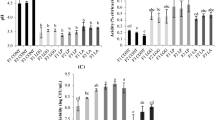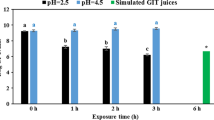Abstract
The stability of nonfermented cashew apple juice (control) and the fermented juice with Lactobacillus casei NRRL B-442 (sweetened and nonsweetened samples) was investigated along the storage at 4 °C for 42 days. The viability of the probiotic bacteria, sugars, lactic acid, and vitamin C content besides color, antioxidant activity, enzyme activity, and sensory characteristics of probiotic cashew apple juice was evaluated. It was observed that viable cell counts increased in the probiotic cashew apple containing sucrose (8 % w/v) along the storage period. Viable cell counts were always higher than 8.00 Log CFU/ml throughout the storage period. Ascorbic acid loss was higher in the nonfermented juice (40 %) compared to the fermented juice (23 %). The same behavior was observed for antioxidant activity and total polyphenolic compounds content, conferring nutritional benefits to this functional food. Browning reactions and nutritional breakdown caused by enzymes were minimized in the fermented samples during storage. In the fermented sample, higher reduction (>70 %) in the polyphenol oxidase enzyme activity was observed. During storage, the increase in the chroma values from 3.2 to 5.0 indicated that the yellow color became more vivid. Sensory analysis of the fermented cashew apple juice revealed that the product was well-accepted, with acceptance percentages above 80 % for the sweetened juice at the end of the storage period.






Similar content being viewed by others
References
Annunziata, A., & Vecchio, R. (2011). Functional foods development in the European market: A consumer perspective. Journal of Functional Foods, 3, 223–228.
Bautista-Garfias, C. R., Ixta, O., Orduña, M., Martínez, F., Aguilar, B., & Cortés, A. (1999). Enhancement of resistance in mice treated with Lactobacillus casei: Effect on Trichinella spiralis infection. Veterinary Parasitology, 80, 251–260.
Brito, E. S., Araujo, M. C. P., Lin, L.-Z., & Harnly, J. (2007). Determination of the flavonoid components of cashew apple (Anacardium occidentale, L.) by LC-DADESI/MS. Food Chemistry, 105, 1112–1118.
Contreras, C. J., Calderon, J. L., Guerra, H. E., & Garcia, V. B. (2011). Antioxidant capacity, phenolic content and vitamin C in pulp, peel and seed from 24 exotic fruits from Colombia. Food Research International, 44, 2047–2053.
Cruz, A. G., Cadena, R. S., Walter, E. H. M., Mortazavian, A. M., Granato, D., & Faria, A. F. (2010). Sensory analysis: Relevance for prebiotic, probiotic, and synbiotic product development. Comprehensive Reviews in Food Safety, 9, 358–373.
Di Cagno, R. D., Minervini, G., Rizzello, C. G., Angelis, M. D., & Gobbetti, M. (2011). Effect of lactic acid fermentation on antioxidant, texture, color and sensory properties of red and green smoothies. Food Microbiology, 28, 1062–1071.
Ellendersen, L. S. N., Granato, D., Guergoletto, K. B., & Wosiacki, G. (2012). Development and sensory profile of a probiotic beverage from apple fermented with Lactobacillus casei. Engineering in Life Sciences, 12, 475–485.
Espinoza, Y. R., & Navarro, Y. G. (2010). Non-dairy probiotic products. Food Microbiology, 27, 1–10.
Faria, C. P., Benedet, H. D., & Guerroue, J. R. (2006). Parâmetros de produção de leite de búfala fermentado por Lactobacillus casei. Pesquisa agropecuária, 41, 16–21.
Figueiredo, A. R., Campos, F., Freitas, V., Hogg, T., & Couto, J. A. (2008). Effect of phenolic aldehydes and flavonoids on growth and inactivation of Oenococcus oeni and Lactobacillus hilgardii. Food Microbiology, 25, 105–112.
Fonteles, T. V., de Costa, M. G., Jesus, A. L. T., & Rodrigues, S. (2011). Optimization of the fermentation of cantaloupe juice by Lactobacillus casei NRRL B-442. Food and Bioprocess Technology. doi:10.1007/s11947-011-0600-0.
Fu, L., Xu, B. T., Xu, X. R., Gan, R. Y., Zhang, Y., Xiq, E. Q., et al. (2011). Antioxidant capacities and total phenolic contents of 62 fruits. Food Chemistry, 129, 345–350.
Gobbetti, M., Di Cagno, R., & De Angelis, M. (2010). Functional microorganisms for functional food quality. Critical Reviews in Food Science and Nutrition, 50, 716–727.
Gómez, F. M., Rodríguez, O. I., Figueroa, B. A., Cruz, R. H., & Ostria, A. M. (2006). Lactobacillus casei ssp. rhamnosus enhances non specific protection against Plasmodium chabaudi AS in mice. Salud Pública de México, 48(6), 498–503.
Granato, D., Branco, G. F., Nazzaro, F., Cruz, A. G., & Faria, J. A. (2010). Functional foods and nondairy probiotic food development: trends, concepts, and products. Comprehensive Reviews in Food Science and Food Safety, 9, 292–302.
Hernandez, T., Estrella, I., Pérez-Gordo, M., Alegría, E. G., Tenorio, C., Ruiz-Larrrea, F., et al. (2007). Contribution of malolactic fermentation by Oenococcus oeni and Lactobacillus plantarum to the changes in the nonanthocyanin polyphenolic composition of red wine. Journal of Agricultural and Food Chemistry, 55, 5260–5266.
Larrauri, J. A., Rupérez, P., & Saura-calixto, F. (1997). Effect of drying temperature on the stability of polyphenols and antioxidant activity of red grape pomace peels. Journal of Agricultural and Food Chemistry, 45, 1390–1393.
Leifert, W. R., & Abeywardena, M. Y. (2008). Cardioprotective actions of grape polyphenols. Nutrition Research, 28, 729–737.
Luckow, T., & Delahunty, C. (2004a). Consumer acceptance of orange juice containing functional ingredients. Food Research International, 37, 805–814.
Luckow, T., & Delahunty, C. (2004b). Which juice is healthier? A consumer study of probiotic nondairy juice drinks. Food Quality Preference, 15, 751–759.
Luckow, T., Sheehan, V., Fitzgerald, G., & Delahunty, C. (2006). Exposure, health information and flavour-masking strategies for improving the sensory quality of probiotic juice. Appetite, 47, 315–323.
Madureira, A. R., Soares, J. C., Pintado, M. E., Gomes, A. M. P., Freitas, A. C., & Malcata, F. X. (2008). Sweet cheese whey matrices inoculated with the probiotic strain L. paracasei LAFTI L26. Dairy Science & Technology, 88, 649–665.
Matsuno, H., & Uritani, I. (1972). Physiological behavior of peroxidase isozymes I sweet potato root tissue injured by cutting or with black rot. Plant & Cell Physiology, 13, 1091–1101.
Meilgaard, M., Civille, G., & Vand Carr, B. T. (1999). Sensory evaluation techniques (p. 387). Boca Raton: CRC.
Michoudjehoun-Mestres, L., Souquet, J. M., Fulcrand, H., Bouchut, C., Reynes, M., & Brillouet, J. M. (2009). Monomeric phenols of cashew apple (Anacardium occidentale L.). Food Chemistry, 112, 851–857.
Miller, N. J., Diplock, A. T., Rice-Evans, C., Davies, M. J., Gopinathan, V., & Milner, A. (1993). A novel method for measuring antioxidant capacity and its application to monitoring the antioxidant status in premature neonates. Clinical Science, 84, 407–412.
Morales-de la Peña, M., Salvia-Trujillo, L., Rojas-Grau, M. A., & Martin-Belloso, O. (2010). Impact of high intensity pulsed electric field on antioxidant properties and quality parameters of a fruit juice–soymilk beverage in chilled storage. LWT—Food Science and Technology, 43, 872–881.
Mousavi, Z. E., Mousavi, S. M., Razavi, S. H., Emam-Djomeh, Z., & Kiani, H. (2011). Fermentation of pomegranate juice by probiotic lactic acid bacteria. World Journal of Microbiology and Biotechnology, 27, 123–128.
Ng, C.-C., Wang, Y. P., Tzeng, W.-S., & Shyu, Y. T. (2011). Lactic acid bacterial fermentation on the production of functional antioxidant herbal Anoectochilus formosanus Hayata. Journal of Bioscience and Bioengineering, 111, 289–293.
Nokthai, P., Lee, V. S., & Shank, L. (2010). Molecular modeling of peroxidase and polyphenol oxidase: substrate specificity and active site comparison. International Journal of Molecular Sciences, 11, 3266–3276.
Nualkaekul, S., Salmeron, I., & Charalampopoulos, D. (2011). Investigation of the factors influencing the survival of Bifidobacterium longum in model acidic solutions and fruit juices. Food Chemistry, 129, 1037–1044.
Obanda, M., Owuor, P. O., & Taylor, S. J. (1997). Flavonol composition and caffeine content of green leaf as quality potential indicators of Kenyan black teas. Journal of the Science of Food and Agriculture, 74, 209–215.
Ong, L., Henriksson, A., & Shah, N. P. (2006). Development of probiotic cheddar cheese containing Lb. acidophilus, Lb. paracasei, Lb. casei and Bifidobacterium spp. and the influence of these bacteria on proteolytic patterns and production of organic acid. International Dairy Journal, 16, 446–456.
Pereira, A. L. F., Maciel, T. C., & Rodrigues, S. (2011). Probiotic beverage from cashew apple juice fermented with Lactobacillus casei. Food Research International, 44, 1276–1283.
Queiroz, C., Lopes, M. L. M., Fialho, E., & Mesquita, M. L. V. (2011). Changes in bioactive compounds and antioxidant capacity of fresh-cut cashew apple. Food Research International, 44, 1459–1462.
Queiroz, C., Silva, A. J. R., Lopes, M. L. M., Fialho, E., & Mesquita, M. L. V. (2011). Polyphenol oxidase activity, phenolic acid composition and browning in cashew apple (Anacardium occidentale, L.) after processing. Food Chemistry, 125, 128–132.
Ranadheera, R. D. C. S., Baines, S. K., & Adams, M. C. (2010). Importance of food in probiotic efficacy. Food Research International, 43, 1–7.
Rodrigues, S., Lona, L. M. F., & Franco, T. T. (2003). Effect of phosphate concentration on the production of dextransucrase by Leuconostoc mesenteroides NRRL B512F. Bioprocess and Biosystems Engineering, 26, 57–62.
Rodrigues, D., Sousa, S., Gomes, A. M., Pintado, M. M., Silva, J. P., Costa, P., et al. (2011). Storage stability of Lactobacillus paracasei as free cells or encapsulated in alginate-based microcapsules in low ph fruit juices. Food Bioprocess Technology. doi:10.1007/s11947-011-0581-z.
Rufino, M. S. M., Alves, R. E., Brito, E. S., Perez-Jimenez, J., Sauro-Calixto, F., & Mancini Filho, J. (2010). Bioactive compounds and antioxidant capacities of 18 non-traditional tropical fruits from Brazil. Food Chemistry, 121, 996–1002.
Shah, N. P. (2007). Functional cultures and health benefits. International Dairy Journal, 17, 1262–1277.
Shah, N. P., Ding, W. K., Fallourd, M. J., & Leyer, G. (2010). Improving the stability of probiotic bacteria in model fruit juices using vitamins and antioxidants. Journal of Food Science, 75, 278–282.
Sohail, A., Turner, M. S., Prabawati, E. K., Coombes, A. G. A., & Bhandari, B. (2012). Evaluation of Lactobacillus rhamnosus GG and Lactobacillus acidophilus NCFM encapsulated using a novel impinging aerosol method in fruit food products. International Journal of Food Microbiology, 157, 162–166.
US National Academy of Sciences (USA). (2000). Dietary reference intakes for vitamin C, vitamin E, selenium and carotenoids. Washington, DC: National Academies Press. 506 pp (A report on the antioxidants and related compounds. Subcommittees on Upper Reference Intake Levels of Nutrients and Interpretation of Uses of Dietary Reference Intakes and the Standing Committee on the Scientific Evaluation of Dietary Reference Intakes. Food and Nutrition Board).
Vinderola, C. G., & Reinheimer, J. A. (2000). Enumeration of Lactobacillus casei in the presence of L. acidophilus. Bifidobacteria and lactic starter bacteria in fermented dairy products. International Dairy Journal, 10, 271–275.
Wissemann, K. W., & Lee, C. Y. (1980). Polyphenoloxidase activity during grape maturation and wine production. American Journal of Enology and Viticulture, 31, 206–211.
Wu, S.-C., Su, Y.-S., & Cheng, H.-Y. (2011). Antioxidant properties of Lactobacillus-fermented and non-fermented Graptopetalum paraguayense E. Walther at different stages of maturity. Food Chemistry, 129, 804–809.
Zepka, L. Q., Borsarelli, C. D., Silva, M. A. A. P., & Mercadante, A. Z. (2009). Thermal degradation kinetics of carotenoids in a cashew apple juice model and its impact on the system color. Journal of Agricultural and Food Chemistry, 57, 7841–7845.
Acknowledgments
The authors thank CNPq for the financial support through the National Institute of Science and Technology of Tropical Fruit and CAPES for their fellowships.
Author information
Authors and Affiliations
Corresponding author
Rights and permissions
About this article
Cite this article
Pereira, A.L.F., Almeida, F.D.L., de Jesus, A.L.T. et al. Storage Stability and Acceptance of Probiotic Beverage from Cashew Apple Juice. Food Bioprocess Technol 6, 3155–3165 (2013). https://doi.org/10.1007/s11947-012-1032-1
Received:
Accepted:
Published:
Issue Date:
DOI: https://doi.org/10.1007/s11947-012-1032-1




